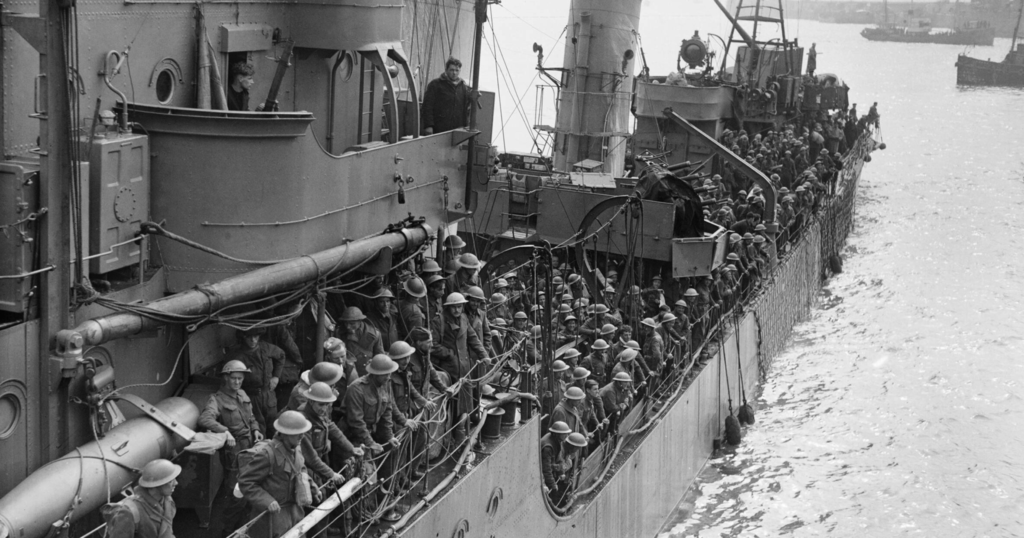One of the greatest military events of the 20th century was not a victorious battle, but a hasty retreat. On May 27, 1940, the “Miracle of Dunkirk” began. British, French, and Belgian troops had retreated to the coast after being overwhelmed by German forces. With their backs to the sea, it seemed they faced inevitable destruction, but the Allied forces fortified the port of Dunkirk and began an evacuation of over 338,000 troops. Although they lost many ships and more than 40,000 men were captured, this miraculous retreat allowed the Allies to survive to fight another day—and eventually defeat the Nazis.
Today the Catholic Church in the United States is facing a similarly dire situation. If we want to survive—and eventually emerge victorious—we need to start planning our own Dunkirk.
Impending Collapse
Although for years many Catholics have lamented the decline of the Catholic Church in America, the situation is far worse than even the most pessimistic projections. How bad things really are is concealed by various demographic factors. For example, the total (self-identified) Catholic population in America has grown from 54.1 million in 1970 to 72.4 million in 2019, a respectable-sounding increase of 34% (statistics from the Center for Applied Research in the Apostolate). However, during the same period, the American population increased by almost twice that much—60%. Further, much of the Catholic increase is driven not by converts or high birth rates, but by immigration from other countries.
And the news is far worse than just not keeping up with the population or being propped up by immigration. During the same time frame (1970 to 2019), the annual number of infant baptisms decreased by 46%—from 1.089 million to 582,000. So at a time when the population has more than doubled, and Catholic immigrants flooded the country, the number of infant baptisms decreased by almost half. This reflects the fact that although many adults still self-identify as Catholic, they do not practice the faith in any meaningful way (after all, they are not even baptizing their kids), which makes it inevitable that their progeny will have no attachment to the Faith.
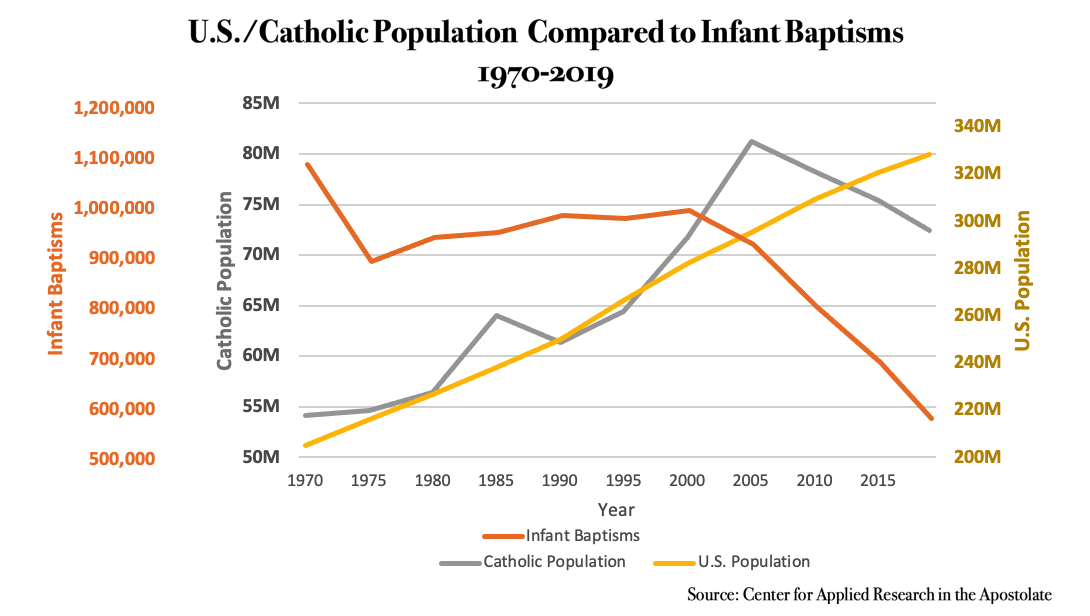
When we look more closely at the numbers, we see that things have begun to disintegrate rapidly in recent years. The rate of decrease in infant baptisms, for example, has not been steady over the past 50 years; the decline has occurred mostly in the past 20 years. In 2000, there were still 996,000 infant baptisms, a decrease of only 8.5% since 1970. Not good, but not a complete collapse. However, in the last 20 years, there’s been a 41.5% decrease in infant baptisms.
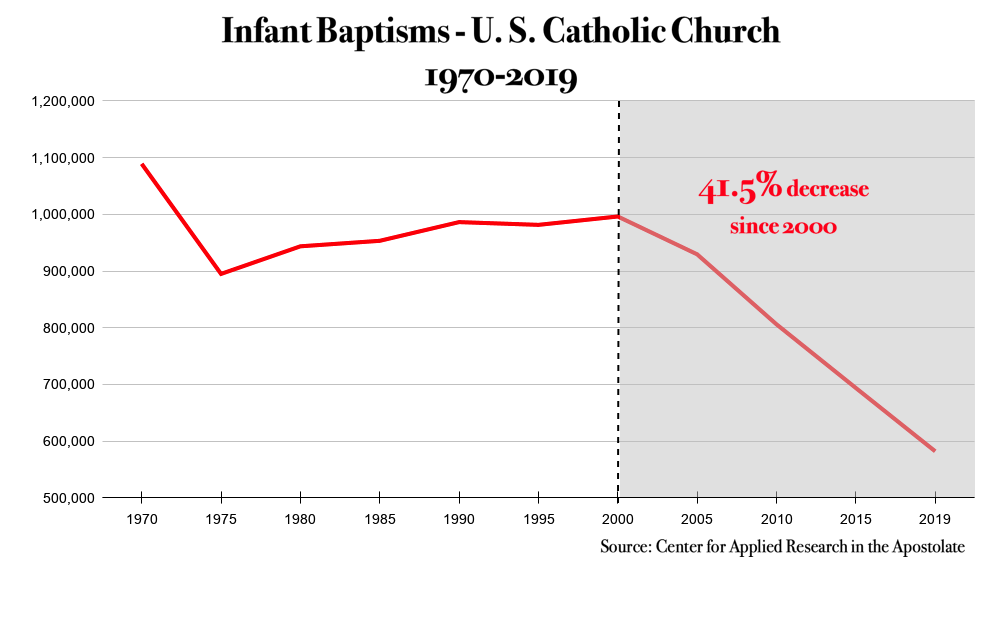
It’s not just infant baptisms: there’s been an even greater decrease in the number of adult baptisms as well (falling 54% since 2005):
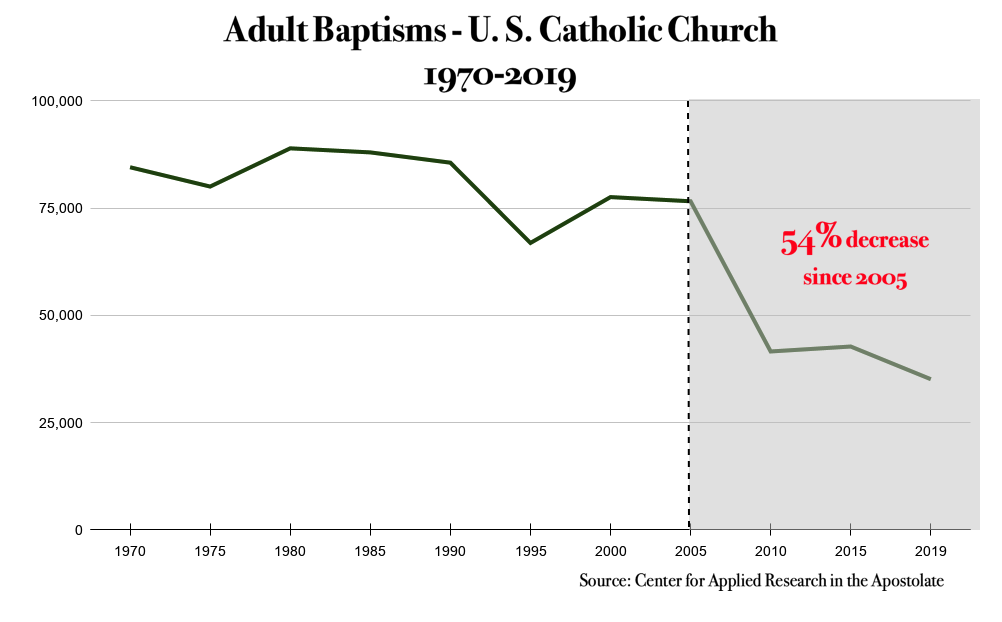
Further, this century has seen a rapidly decreasing number of self-identified Catholics (declining 10.8% in the past 15 years):
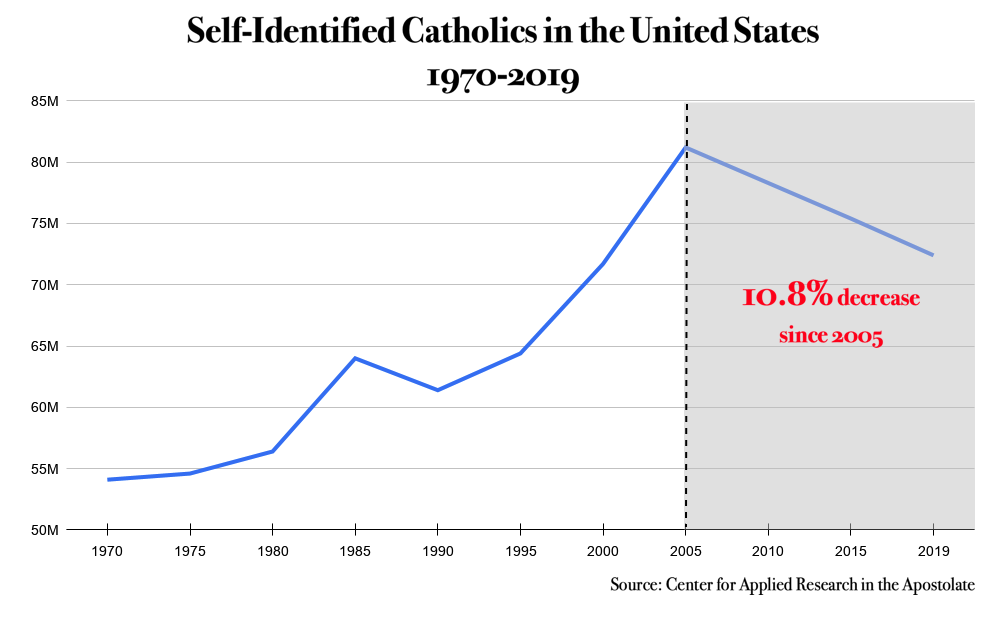
Not surprisingly, the number of Catholics who attend Mass every week has also sharply declined this century (31% since 2000):
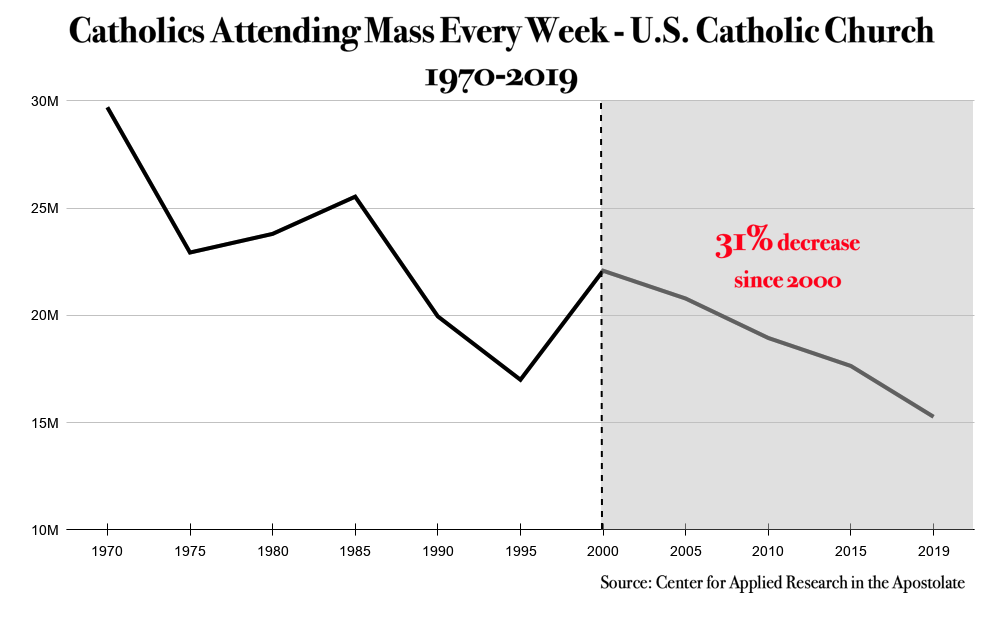
Finally, there is one number that is increasing: the number of self-identified “former Catholics” (increasing 151%[!] since 2000):
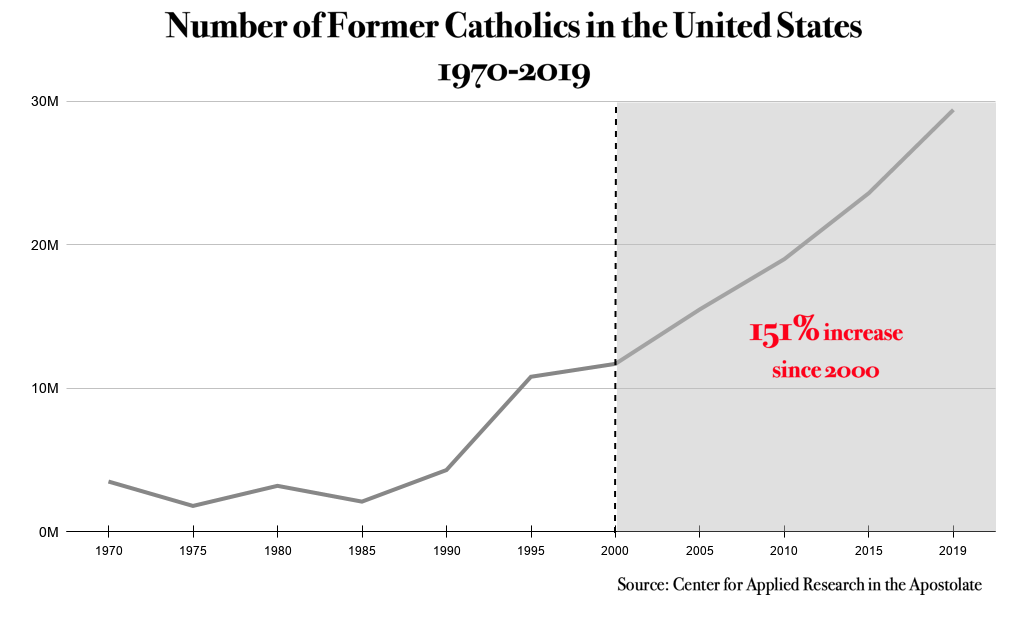
And if these trends aren’t depressing enough, it’s likely things will get worse. The McCarrick scandal was only two years ago; how it will increase the ranks for former Catholics is still unknown. The recent suspension of all public Masses in the United States in response to Covid-19 has broken many Catholics’ habit of attending Sunday Mass, a habit that for many was already teetering on the edge. How many Catholics will come back to Mass once the doors are fully open again? And if they don’t come back, will their children? Unlikely.
So it’s not alarmist to say the Catholic Church in America is facing an overwhelming enemy, much like the Allied forces were overwhelmed on May 27, 1940.
Retreat, Not Surrender
In the face of this coming implosion, what is the Church to do? Most Church leaders effectively say, “Keep the status quo!” Others of a more evangelical bent might say, “We need to do more outreach!” I’ve been involved in Catholic evangelization efforts for decades and was a diocesan Director of Evangelization for five years, so I’m sympathetic to the latter response. However, I’m now convinced we are in a Dunkirk moment, and we need to act accordingly.
Before I explain how the Church might pull off its own “Miracle at Dunkirk,” let’s be clear what the Dunkirk evacuation was not: it was not a surrender. In war it’s sometimes necessary to retreat in order to gather your strength for later battles. A retreat can be honorable and prudent. When it comes to the Church’s mission in the world, a surrender is never acceptable, but a temporary retreat can be the most prudent course of action.
Another thing Dunkirk was not: it was not a panicked fleeing from trouble. Dunkirk is called a “miracle,” but in reality it was a well-executed evacuation that involved the coordination of many leaders and thousands of men. Had it been an every-man-for-himself situation, massive casualties would have ensued. Instead, through courage, heroism, and determination, the Allied troops accomplished their objective, beyond even their own hopes.
Our Dunkirk
How then should the Church’s Dunkirk proceed? Obviously the first thing is to get our Church leaders—particularly bishops and parish pastors—to realize we are in a Dunkirk moment. Pretending that everything is fine not only ignores the complete collapse that will inevitably happen (and is happening now), but it leaves us in a weaker position to recover from it. And we can’t pretend that Christ’s promise that the gates of hell won’t prevail against the Church (Mt 16:18) will keep this collapse from happening. History has shown that this promise does not protect the Church’s presence in every geographic region in the world: Catholicism was completely overwhelmed in North Africa after the rise of Islam, and the local church quickly succumbed to King Henry VIII in 16th-century England.
Second, as in any retreat, we must leave behind everything non-essential. During the Dunkirk evacuation, the priority was getting the men to safety; if they had to leave behind personal belongings, or even military apparatus, then so be it. The men came first. Likewise, our dioceses and parishes need to jettison everything non-essential to surviving the collapse. Since the collapse will also entail a financial reckoning, the dioceses and parishes will have to trim their activities anyway. This means a hard look at what is essential and what is non-essential.
Of course, the first thing to be jettisoned are any diocesan or parish activities that aren’t directly related to strengthening the faith of those few Catholics who remain. Youth sports, community social groups, interreligious outreaches, and other such extraneous activities might have at one time seemed like good ideas, but now they use up resources with little spiritual return.
And the cuts need to be deeper than the obvious. As one example: we need to question whether to continue Catholic schools as they are currently structured. Is it essential to spend an inordinate amount of money to maintain a barely-Catholic school that educates barely-practicing children of barely-practicing parents? Having these schools hasn’t prevented the collapse; keeping them only directs limited resources away from the Church’s core mission, which is the salvation of souls.
Rethink the Status Quo
Finally, we need to plan for the future. After the Allied forces successfully retreated back to England, they didn’t just say, “Let’s keep doing what we’ve been doing—it’s sure to work next time!” No, they realized that the status quo would simply lead to more losses. Likewise, dioceses and parishes can’t keep trying to reach lukewarm Catholics with the same methods that drove them to their lukewarmness in the first place.
In the face of the unrelenting blitzkrieg which has inflicted so many losses on the Church for decades, we need to question how things operate in the Church. We must rethink everything: youth ministry, religious education, the number of parishes, priestly assignments…the list could go on and on. Although many of the ways parishes and dioceses do things were begun with good intentions, that does not mean they are suited to the current crisis.
And we can’t be content in simply rejecting the failed post-conciliar status quo—we must discover where Catholicism is currently thriving in America. Although the overall Church is in a state of free-fall, there are pockets of growth. The most prominent pocket is young homeschooling families, many of whom attend the Traditional Latin Mass. Instead of eyeing these families with suspicion, Church leaders need to embrace them and learn from them. Why are modern young people attracted to traditional forms of piety, be it the liturgy or popular devotions? How can we encourage those forms more broadly? Further, why do these families distrust conventional Catholic schools? Perhaps their criticisms have merit and shouldn’t be ignored or mocked.
No one wants to hear bad news. Yet ignoring bad news usually makes a situation worse. And the news is beyond bad for the Catholic Church in America: we are cornered and facing imminent collapse. Will we foolishly maintain the status quo, pretending we can engage the overwhelming enemy on his turf, or will we execute a well-planned retreat that will strengthen us for victory in the future?
Image: Troops evacuated from Dunkirk on a destroyer about to berth at Dover, 31 May 1940.

